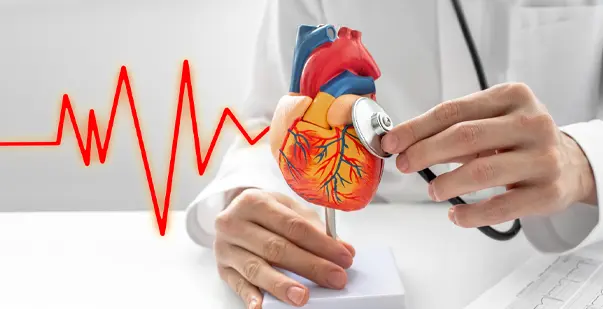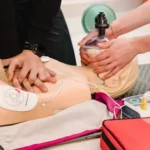Shockable rhythms are abnormal heart rhythms. These can be treated with an electric shock which is given by a defibrillator. These rhythms include ventricular fibrillation and pulseless ventricular tachycardia. They are life-threatening to a great extent because they disrupt the heart’s ability to pump blood effectively.
So, the shock from a defibrillator helps to restore the normal rhythm of the heart by stopping all electrical activity for a brief moment. This allows the heart’s natural pacemaker to regain control and resume a regular heartbeat. Let us explore why early recognition and treatment of shockable rhythms are crucial for saving lives in cardiac emergencies.
What are the two main shockable rhythms encountered in cardiac arrest?
In cardiac emergencies, there are two main shockable heart rhythms:

source:https://en.wikipedia.org/wiki/Ventricular_fibrillation#/media/File:Ventricular_fibrillation.png
Chaotic Heartbeat (VF):
In this case, the heart’s lower chambers quiver irregularly. It needs quick treatment with a defibrillator.
Fast, Irregular Beat (VT):
The heart’s lower chambers beat too quickly and irregularly which requires immediate defibrillation for better blood flow.
Read more: Online ACLS Certification Vs. Local ACLS Certification
How do healthcare professionals identify shockable rhythms during cardiac arrest?
In ACLS emergencies, healthcare professionals identify shockable rhythms through:
ECG Monitoring:
This involves tracking heart activity for abnormalities like VF and VT.
Pulse Check:
It entails assessing pulse presence to detect cardiac arrest.
Clinical Signs:
This includes Observing unresponsiveness, absence of breathing, and cyanosis.
Patient History:
Reviewing medical background for insights into shockable rhythms is initiated.
What role do automated external defibrillators (AEDs) play in managing shockable rhythms?
In managing shockable rhythms, automated external defibrillators (AEDs) play a major role:
Prompt Intervention:
AEDs give immediate access to defibrillation. This is essential for restoring normal heart rhythm during cardiac arrest.
Simplified Operation:
Designed for ease of use, AEDs guide bystanders and healthcare providers through step-by-step instructions for delivering shocks with efficacy.
Increased Survival Rates:
Early defibrillation with AEDs improves the chances of survival for individuals with shockable rhythms. Particularly, in settings where immediate access to medical professionals is limited.
Accessibility:
AEDs are widely available in public spaces, workplaces, and healthcare facilities, ensuring rapid deployment in emergencies to save lives.
How do shockable rhythms differ from non-shockable rhythms?
H3: When it comes to cardiac emergencies, understanding the difference between shockable and non-shockable rhythms is crucial. They differ in heart activity, treatment, and prognosis.
| Aspect | Shockable Rhythms | Non-Shockable Rhythms |
| Definition | Abnormal heart rhythms that respond to defibrillation, such as ventricular fibrillation (VF) and pulseless ventricular tachycardia (VT). | Abnormal heart rhythms that do not respond to defibrillation, such as asystole and pulseless electrical activity (PEA). |
| Heart Activity | Characterized by chaotic or rapid electrical activity in the heart’s lower chambers. | Typically involves the absence of organized electrical activity or ineffective pumping of the heart. |
| Treatment | Requires immediate defibrillation to restore normal heart rhythm and circulation. | Treatment focuses on identifying and addressing underlying causes, such as administering medications or addressing reversible factors. |
| Prognosis | Immediate defibrillation significantly improves the chances of survival. | Prognosis is generally poorer, often requiring advanced interventions |
What are the key steps in delivering defibrillation for shockable rhythms?
In managing shockable rhythms, delivering defibrillation involves several key steps:
Preparation:
Ensure safety of surroundings and gather necessary equipment, including an automated external defibrillator (AED).
Assessing the Patient:
Confirm cardiac arrest, check for unresponsiveness and absence of breathing, and quickly assess for shockable rhythm using an AED or manual defibrillator.
Applying Defibrillator Pads:
Follow AED prompts or proper placement guidelines for attaching pads to the patient’s chest.
Analyzing Rhythm:
Allow the AED to analyze the heart rhythm to determine if a shockable rhythm, such as ventricular fibrillation (VF) or pulseless ventricular tachycardia (VT), is present.
Delivering Shock:
If advised by the AED, deliver a shock by pressing the appropriate button, ensuring everyone is at a distance from the patient.
Post-Shock Assessment:
Immediately resume CPR after the shock. Continue until emergency medical services arrive or the patient shows signs of recovery.
Read more: What role does ECPR play in the management of cardiac arrest?
Conclusion
Hence, understanding and prompt handling lead to positive outcomes by preventing sudden loss of lives due to cardiac failures. AEDs are a real game-changer in increasing the quality and speed of defibrillation and consequently survival rates. Healthcare professionals who can monitor devices, pulse checks, and clinical signs should be able to identify shockable rhythms. Knowledge of the major points in defibrillation response, preparation, electric shock, and post-shock assessment, is important for providing aid quickly. This makes the victim more likely to survive and have a good prognosis. Early recognition, quick defibrillation, and joint efforts can save lives for those who experience cardiac emergencies






